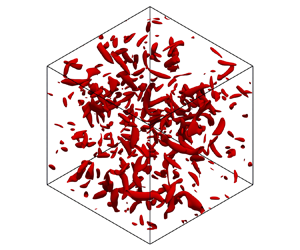No CrossRef data available.
Published online by Cambridge University Press: 21 February 2025

The lattice Boltzmann method has become a popular tool for simulating complex flows, including incompressible turbulent flows; however, as an artificial compressibility method, it can generate spurious pressure oscillations whose impact on the statistics of incompressible turbulence has not been systematically examined. In this work, we propose a theoretical approach to analyse the origin of compressibility-induced oscillations (CIOs) and explore ways to suppress or remove them. We begin by decomposing the velocity field and pressure field each into the solenoidal component and the compressive component, and then study the evolution of these two components analytically and numerically. The analysis yields an evolution equation of the mean-square pressure fluctuation which reveals several coupling effects of the two components. The evolution equation suggests that increasing the bulk-to-shear viscosity ratio can suppress CIOs, which is confirmed by numerical simulations. Furthermore, based on the derived evolution equation and data from the simulation, a model is developed to predict the long-term behaviours of the mean-square pressure fluctuations. In the case of decaying turbulence in a periodic domain, we show that the Helmholtz–Hodge decomposition can be used to obtain the solenoidal components reflecting the true evolution of incompressible turbulent flow, from the mesoscopic artificial compressibility approach. The study provides general theoretical guidelines to understand, suppress and even remove CIOs in other related pseudo-compressibility methods.